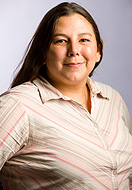News
First female Native-American earns PhD in engineering at UB
-
 Print
Print -
 Comments
Comments
-

The Great Law of the Haudenosaunee has guided Shannon Seneca’s academic career. Photo: DOUGLAS LEVERE
Seeing the Rocky Mountains usually tops the list of things to do when visiting Colorado.
Not for Shannon Seneca, who vacationed there after graduating high school 15 years ago. Upon landing in Denver, she headed straight for the Rocky Flats Plant, a former nuclear weapons production facility.
“It wasn’t even open to the public,” she recalls. “I actually talked the people working there into giving me a tour.”
The visit solidified Seneca’s interest in nuclear waste and helped lead her to UB, where on May 12 she became what’s believed to be the first female Native-American to earn a doctoral degree from the School of Engineering and Applied Sciences.
Seneca credits her background—she is a Mohawk and part of the Six Nations community based near Brantford, Ont.—as the guiding force behind her studies. As a child, she was told the Great Law of the Haudenosaunee (Iroquois Confederacy), which essentially says that people should consider how their decisions will affect future generations.
She received a BS in physics at Buffalo State College in 2001 and an MS in environmental engineering from UB in 2006. She then began working with Alan Rabideau, professor of civil, structural and environmental engineering at UB.
Rabideau has been studying groundwater contamination at the West Valley nuclear fuel reprocessing center for years. In 2007, he received funding from the National Science Foundation (NSF) to create a program called Ecosystem Restoration through Interdisciplinary Exchange (ERIE), which helps train new environmental scientists in nontraditional ways to repair impaired environments.
Seneca joined the program, which included a groundbreaking effort to remove radioactive waste from West Valley, located 30 miles south of Buffalo. She helped Rabideau develop a permeable wall that when placed underground, filters and removes strontium-90 from the soil. Strontium-90 is found in spent nuclear fuel rods.
“Shannon’s contributions, from extensive lab testing to helping develop complex mathematical models, as well as her collegiality and commitment to interdisciplinary work, have been invaluable to the ERIE program and the Western New York community,” Rabideau says.
In addition to her studies, Seneca has been involved in numerous Native American-related student activities. She helped found a local chapter of the American Indian Science and Engineering Society, and has worked in the Buffalo Public Schools Native American Magnet School under a NSF grant led by Joseph A. Gardella Jr., John and Francis Larkin Professor of Chemistry at UB.
Seneca also helped mentor other Native-American engineering students at UB, two of whom earned their master’s degrees the same day she received her doctorate.
“It’s been amazing,” she says of her time at UB.

Reader Comments